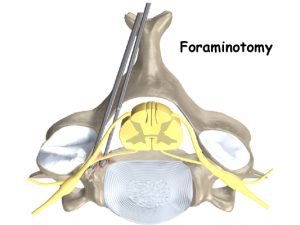Lumbar Foraminotomy- Facetectomy Surgery
For Arm, Leg, Or Face Pain Relief
Nerves leave the spinal canal through openings which are called neural foramen. The roof of the neural foramen is composed of joints from the vertebral body above and below. These joints are known as facet joints. The neural foramen can become crowded with disc material, bone spurs or thickened ligament. When this occurs, a nerve leaving through the foramen is compressed. The patient may experience pain in the leg or arm as a result of this nerve compression.
In order to remove the pressure on the nerve, the neurosurgeon may remove some of the offending disc material, bone spur or ligament, which is known as a foraminotomy. When this removal is not sufficient, the whole facet joint may need to be removed. In this case, the procedure is called a facetectomy. A foraminotomy can be performed without a fusion, but a facetectomy will often require a fusion.

This surgery is generally performed to relieve leg or arm pain.
Before the operation begins, the anesthesiologist will put the patient to sleep. The patient will then be turned on to their stomach in the operating room. This is done in an extremely careful manner to protect all pressure points. After the appropriate antibiotics are given, x-ray may be used to guide the placement of the incision. The incision is performed in the midline.
When the lamina or roof of the spinal canal is exposed, the surgeon then removes a small portion while visualizing it under the microscope. Either disc, bone spur or ligament is removed to decompress the spinal nerve as it leaves the neural foramen. Micro-instruments are used to make sure that the nerves are completely free. After this is done, the wound is irrigated with an antibiotic solution and closed. Unlike a foraminotomy, a fusion may be required during surgery to stabilize the spine.
Patients undergoing a foraminotomy are generally discharged home the day of or the day following surgery. When a facetectomy with fusion is performed, the patient’s hospital stay may be a day or two longer.
The pain in the leg is typically significantly improved, although the patient may experience numbness in the leg, twinges of leg pain, pain around the incision and, at times, spasms of the back muscles. Medications will be given for this. This should improve within one to two weeks after surgery.
Patients should keep their back incisions dry until they are seen in the office, generally seven to ten days after surgery. They should try to avoid any bending, lifting or twisting for four to six weeks. Depending upon the type of work they do for a living and how strenuous their job requirements are, they may return to work within two to four weeks with some temporary restrictions
Risks of the surgery are generally low. Potential risks include bleeding, infection, nerve injury, spinal fluid leak and recurrence of another disc herniation at the same level.